Dear Zazie, Here is today’s Lovers’ Chronicle from Mac Tag dedicated to his muse. Follow us on twitter @cowboycoleridge. Rhett
The Lovers’ Chronicle
Dear Muse,
this one born of dreams
“One we have fulfilled”
as if i had said;
i will create it
and she will come
“You conjurer you”
certainly seems so
i was tryin’ to find myself,
my purpose, and searchin’
for a way to process the pain,
but also to be found
“And I did”
yes, glad you joined this vision
© copyright 2023 mac tag/cowboycoleridge all rights reserved
well not quite so dramatic as this, but… feelin’ that existence is not worth havin’ without you, repudiate all and rush off to find you, to tell you nothin’ else matters, just this right here, and it can be everything, givin’, openin’, welcomin’, grateful
© copyright 2022 mac tag/cowboy coleridge all rights reserved
© copyright 2020 mac tag/cowboy coleridge all rights reserved
into the night sky
ridin’ the wind, there
doin’ penance
in the space of the mind
precise and certain
from the madness
encounterin’
every impulse
whisperin’
‘Let it not
to have been in vain’
what we see, we see
and seein’ is changin’
the light
leaves
heartbeat
sweatin’ through
the impulse
pourin’ in
tryin’ to translate
into images
for all there is
as close to redemption
© copyright 2019 mac tag/cowboy coleridge all rights reserved
no, never like,
they were
imprisoned words
no blood, no sight
on the Great Plains
arias of grass at sunset
flowin’ in the wind
he who shivers
at the bloomin’ of light,
in these eyes searchin’
a purebred flock of stars
forged
in martyrdom, the bell tolls
seasoned with shadows
it survives, a pastoral howl
© copyright 2018 mac tag/cowboycoleridge all rights reserved
what means these visions…
ridin’ through a desert
tired, we push on as if
doin’ penance for sins
we reach a spring
and camp for the night
sleep comes
as the constellations
crawl across the big sky
we part, knowin’
we have seen
the last of each other
as the distance grows
morose feelin’s take hold
and longin’ consumes
then, visions within
the vision… the first
erotic, i reach for you
you laugh and turn away
the next one…
that you need me
nothin’ worth nothin’
without you
repudiate all vows
and rush to find you
© copyright 2017 mac tag/cowboy Coleridge all rights reserved
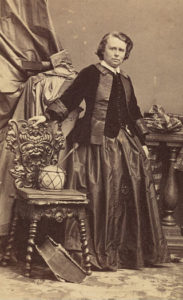 Today is the birthday of Rosa Bonheur (born Marie-Rosalie Bonheur, Bordeaux, France, 16 March 1822 – 25 May 1899 Thomery, France); artist, an animalière (painter of animals) and sculptor, known for her artistic realism. Her best-known paintings are Ploughing in the Nivernais, first exhibited at the Paris Salon of 1848, and now at the Musée d’Orsayin Paris, and The Horse Fair (in French: Le marché aux chevaux), which was exhibited at the Salon of 1853 (finished in 1855) and is now in the Metropolitan Museum of Art, in New York City. Bonheur, in my opinion, was one of the most famous female painters of the nineteenth century.
Today is the birthday of Rosa Bonheur (born Marie-Rosalie Bonheur, Bordeaux, France, 16 March 1822 – 25 May 1899 Thomery, France); artist, an animalière (painter of animals) and sculptor, known for her artistic realism. Her best-known paintings are Ploughing in the Nivernais, first exhibited at the Paris Salon of 1848, and now at the Musée d’Orsayin Paris, and The Horse Fair (in French: Le marché aux chevaux), which was exhibited at the Salon of 1853 (finished in 1855) and is now in the Metropolitan Museum of Art, in New York City. Bonheur, in my opinion, was one of the most famous female painters of the nineteenth century.
In a world where gender expression was literally policed, Bonheur broke boundaries by deciding to wear pants, shirts and ties. She did not do this because she wanted to be a man, though she occasionally referred to herself as a grandson or brother when talking about her family; rather, Bonheur identified with the power and freedom reserved for men. Wearing men’s clothing gave Bonheur a sense of identity in that it allowed her to openly show that she refused to conform to societies’ social construction of the gender binary. It also broadcast her sexuality at a time where the lesbian stereotype consisted of women who cut their hair short, wore pants, and chain-smoked. Bonheur did all three. Bonheur never explicitly said she was a lesbian but her lifestyle and the way she talked about her female partners suggests this.
She had two female partners in her lifetime; the first, Nathalie Micas, Bonheur grew up with and then lived with for forty years and the second, Anna Klumpke, came into her life after the death of her first partner. Bonheur, while taking pleasure in activities usually reserved for men, such as hunting and smoking, viewed her womanhood as something far superior to anything a man could offer or experience. She viewed men as stupid and mentioned that the only males she had time or attention for were the bulls she painted.
Having chosen to never become an adjunct or appendage to a man in terms of painting, she decided she would be her own boss and that she could lean on herself and her female partners instead. She had her partners focus on the home life while she took on the role of breadwinner by focusing on her painting. Bonheur’s legacy paved the way for other lesbian artists who didn’t favour the life society laid out for them.
Gallery
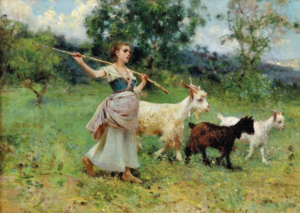

The Horse Fair (1852–55; Metropolitan Museum of Art)

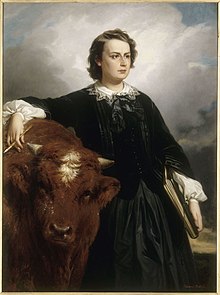




-

Palette, Minneapolis Institute of Art
-

Study of a Cow. Courtesy Figge Art Museum.
-

Study of a Dog, possibly 1860s, Princeton University Art Museum
-

Relay Hunting
-

Head of a Bull. Brooklyn Museum
-

Portrait de Col. William F. Cody
-

The Highland Shepherd
-

Sangliers dans la neige, or Wild boars in the snow.
-
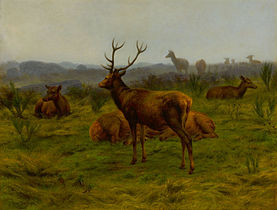
Le monarque de la meute, The Monarch of the herd
-

Royale à la maison
-

Bonheur, 1865, wearing the Legion of Honour
-
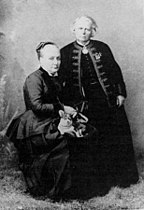
Bonheur & Natalie Micas, Nice, 1882
-

Bonheur, c. 1889
 Today is the birthday of poet Sully Prudhomme (Paris 16 March 1839 – 6 September 1907 Châtenay-Malabry, France). His first volume of poetry, Stances et Poemes (Stanzas and Poems) (1865), was well reviewed and established his reputation. The volume was filled with fluent and melancholic verse inspired by an unhappy love affair. Such as these, the Poems of the Day:
Today is the birthday of poet Sully Prudhomme (Paris 16 March 1839 – 6 September 1907 Châtenay-Malabry, France). His first volume of poetry, Stances et Poemes (Stanzas and Poems) (1865), was well reviewed and established his reputation. The volume was filled with fluent and melancholic verse inspired by an unhappy love affair. Such as these, the Poems of the Day:
Le Vase brisé
Le vase où meurt cette verveine
D’un coup d’éventail fut fêlé ;
Le coup dut l’effleurer à peine :
Aucun bruit ne l’a révélé.
Mais la légère meurtrissure,
Mordant le cristal chaque jour,
D’une marche invisible et sûre,
En a fait lentement le tour.
Son eau fraîche a fui goutte à goutte,
Le suc des fleurs s’est épuisé ;
Personne encore ne s’en doute,
N’y touchez pas, il est brisé.
Souvent aussi la main qu’on aime,
Effleurant le cœur, le meurtrit ;
Puis le cœur se fend de lui-même,
La fleur de son amour périt ;
Toujours intact aux yeux du monde,
Il sent croître et pleurer tout bas
Sa blessure fine et profonde ;
Il est brisé, n’y touchez pas.
Never To See Or Hear Her
Never to see or hear her,
never to name her aloud,
but faithfully always to wait for her
and love her
To open my arms and, tired of waitin’,
to close them on nothin’,
but still always to stretch them out to her
and to love her
To only be able to stretch them out to her,
and then to be consumed in tears,
but always to shed these tears,
always to love her
Never to see or hear her,
never to name her aloud,
but with a love that grows ever more tender,
always to love her… Always
The Song of the Day is from the great Smokey Robinson – “Just to See Her”.
Never to see you. Always to long, just to see you.
And on this day in 1894 – Jules Massenet’s opera Thaïs is first performed.
| Thaïs | |
|---|---|
| Opera by Jules Massenet | |

Original poster, design by Manuel Orazi
|
|
Thaïs is a comédie lyrique opera in three acts and seven tableaux, by Jules Massenet to a French libretto by Louis Gallet, based on the novel Thaïs by Anatole France. It was first performed at the Opéra Garnier in Paris, starring the American soprano Sibyl Sanderson, for whom Massenet had written the title role. The original production was directed by Alexandre Lapissida, with costumes designed by Charles Bianchini and sets by Marcel Jambon (act 1, scene 1; act 3) and Eugène Carpezat (act 1, scene 2; act 2). The opera was later revised by the composer and was premiered at the same opera house on 13 April 1898.
The work was first performed in Italy at the Teatro Lirico Internazionale in Milan on 17 October 1903 with Lina Cavalieri in the title role and Francesco Maria Bonini as Athanaël. In 1907, the role served as Mary Garden’s American debut in New York in the U.S. premiere performance.
Thaïs takes place in Egypt during Byzantine rule, where a Cenobite monk, Athanaël, attempts to convert Thaïs, an Alexandrian courtesan and devotee of Venus, to Christianity, but discovers too late that his obsession with her is rooted in lust. While the courtesan’s true purity of heart is revealed, so is the religious man’s baser nature. The work is often described as bearing a sort of religious eroticism, and has had many controversial productions. Its famous Méditation, the entr’acte for violin and orchestra played between the scenes of act 2, is an oft-performed concert music piece; it has been arranged for many different instruments.
The role of Thaïs, similar to another Massenet heroine also written for Sibyl Sanderson, Esclarmonde, is notoriously difficult to sing and is reserved for only the most gifted of performers. Modern interpreters have included Carol Neblett, Anna Moffo, Beverly Sills, Leontyne Price, Renée Fleming, and Elizabeth Futral. Géori Boué was the first to record the opera, in 1952.
Synopsis
Act 1
Scene 1
A group of Cenobite monks go about their daily business. Athanaël, the most rigorous ascetic of them all, enters and confesses to the senior monk, Palémon, that he has lately been disturbed by visions of a courtesan and priestess of Venus named Thaïs, whom he had seen many years ago in his native city of Alexandria. Believing these visions to be a sign from God, he resolves, against Palémon’s advice, to return to Alexandria, convert Thaïs to Christianity, and persuade her to enter a convent.
Scene 2
Athanaël arrives in Alexandria and visits his old friend Nicias, a wealthy voluptuary. Nicias welcomes him with open arms and reveals himself to be Thaïs’s current lover. Upon hearing Athanaël’s plan, he laughs and warns him that the revenge of Venus can be terrible. Nevertheless, he procures clothing for his friend in preparation for a feast that evening at which Thaïs will appear. His slaves, Crobyle and Myrtale, dress Athanaël and mock his prudery.
The feast begins. Thaïs arrives and sings a bittersweet love duet with Nicias: this is their last night together. She then asks him about Athanaël, who overhears her and tells her that he has come to teach her “contempt for the flesh and love of pain.” Not tempted by this proposition, she offends his sense of propriety with a seductive song. He leaves, angrily promising to come back later, while she taunts him with a parting shot: “Dare to come, you who defy Venus!” and begins to disrobe as the curtain falls.
Act 2
Scene 1
Exhausted after the feast, Thaïs expresses dissatisfaction with her empty life and muses on the fact that one day, old age will destroy her beauty. Athanaël enters at this vulnerable moment, praying to God to conceal her beauty from him. He tells her that he loves her according to the spirit rather than the flesh, and that his love will last forever instead of a single night. Intrigued, she asks him to teach her the ways of this love. He nearly succumbs to her physical charm, but succeeds in explaining to her that if she converts, she will gain eternal life. She nearly succumbs to his eloquence, but then reasserts her nihilistic worldview and drives him away. However, after a long meditation she changes her mind.
Scene 2
Thaïs has joined Athanaël and resolved to follow him into the desert. He orders her to burn down her house and possessions in order to destroy all traces of her wicked past. She agrees, but asks if she can keep a statuette of Eros, the god of love, explaining to Athanaël that she sinned against love rather than through it. When he hears that Nicias gave it to her, however, Athanaël demands that she destroy it. Nicias appears with a group of revelers, who see Athanaël taking Thaïs away. Furious, they begin to stone him. Although Nicias is astonished at Thaïs’ decision to leave, he respects it and throws handfuls of money to distract the crowd. Thaïs and Athanaël escape.
Act 3
Scene 1
Thaïs and Athanaël travel on foot through the desert. Thaïs is exhausted, but Athanaël forces her to keep going and thus do penance for her sins. They reach a spring, where Athanaël begins to feel pity rather than disgust for her, and they share a few moments of idyllic, platonic companionship as they rest. Shortly afterwards, they reach the convent where Thaïs is to stay. Placing her in the care of Mother Superior Albine, Athanaël realizes that he has accomplished his mission — and that he will never see her again.
Scene 2
The Cenobite monks express anxiety over Athanaël’s asocial and morose behavior since his return from Alexandria. Athanaël enters and confesses to Palémon that he has begun to experience sexual longing for Thaïs. Palémon castigates him for having attempted to convert her in the first place. Athanaël falls into a depressed sleep and has an erotic vision of Thaïs. He tries to seize her, but she laughingly evades him. Then, a second vision tells him that Thaïs is dying.
Scene 3
Feeling that existence is worth nothing without her, he repudiates all his vows and rushes off to find her. He reaches the convent and finds her on her deathbed. He tells her that all he taught her was a lie, that “nothing is true but life and the love of human beings”, and that he loves her. Blissfully unaware, she describes the heavens opening and the angels welcoming her into their midst. She dies, and Athanaël collapses in despair.

Mac Tag

No Comments on "The Lovers’ Chronicle 16 March – visions – art by Rosa Bonheur – verse by Sully Prudhomme – premiere of Massenet’s Thaïs"